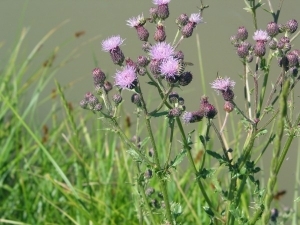
I almost used the word spring and summer ahead of the word garden in the first sentence because my difficulty with red is limited to the blooming season. In the fall and winter bring on the red.
Every landscape needs a focal point and since most of our fall colors are built around yellows, red is that focal point. In the fall or winter my attention is always drawn to red.
Four shrubs quickly come to mind if you are looking for red fall foliage. The most common is the Euonymus alata, commonly called burning bush. The other three are sweetspire, choke-cherries and smooth witherrod. The latter three are natives.
Burning bush has been a standard for as long as I can remember. The others have emerged because they are natives and do not share the many insect and disease problems common with euonymus. Some also fear that this plant can become invasive. My observations are that both problems are much less than is often reported although I am now selecting the other three for my plantings.
Sweetspire orItea virginica, in addition to excellent red fall color, adds a white spring bloom and a winter stem color with some ornamental value. This plant will grow anywhere but I would keep it out of windy spots and site it out of the full afternoon sun.
Choke cherry,Aronia, also produces black or red berries. The red-berried varieties seem to have better leaf retention than its black counterpart. This berry is not the first choice of our birds.
Smooth witherrod orViburnum nudumgets a deep mahogany leaf that is just now beginning to change. It also will sport deep blue and pink berries if a pollinator is also planted. Two common cultivars are ‘Brandywine’ and Winterthur’. Both were named for local landmarks.
The other fall red that generally persists into winter are plants with red berries. These include the hollies, both evergreen and deciduous, as well as many viburnums. In each case you need a pollinator to get berries. In the case of hollies- a male and female are both required, but only the female will fruit. For viburnums, two cultivars of the same species are needed to cross pollinate and BOTH will fruit.
The final red shrub that I prize for winter is the red-twig dogwood;Cornus stoloniferais the Latin. This plant is also a native, but as usual, selections of the native are most often used in our landscapes. A great new dwarf selection is ‘Pucker Up’ with corrugated leaves and the same great red stems.
My favorite fall tree for red color is the maple,Acer rubrum. That is our native maple which generally has smaller leaves and probably gets its name from the color of its spring buds. This is a maple. That said I quickly add that it does not share the real nasty surface root structure that is common with the large leafed maples. It also does not provide the dense shade common with some maples.
There is an aging gnarled American red maple growing in a waterway on the farm. It was there long time before I built my house. Every fall I am treated to a brilliant red display.
Nearby are other seedlings of the same tree, which show great variability in leaf retention and color. I guess that is why in the market place you will generally find selections of this native plant. There are some really good ones.
Do they bullfight in the fall and winter? If they do they must share red with my garden.
Viburnum dilatatum 'Cardinal Candy' planted along our fencerow. Plant another V. dilatatum for best fruit set.
 Last week I was pulling Canada thistle on the farm, and lamenting that this weed was the bane of my existence. A customer casually remarked that they don’t see it too much in North Jersey, but noticed lot around here, especially in meadows and roadsides.
Last week I was pulling Canada thistle on the farm, and lamenting that this weed was the bane of my existence. A customer casually remarked that they don’t see it too much in North Jersey, but noticed lot around here, especially in meadows and roadsides.